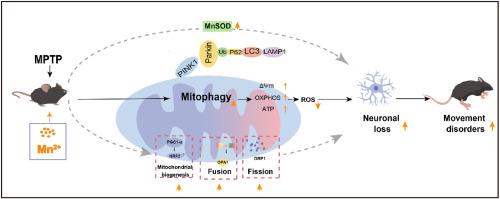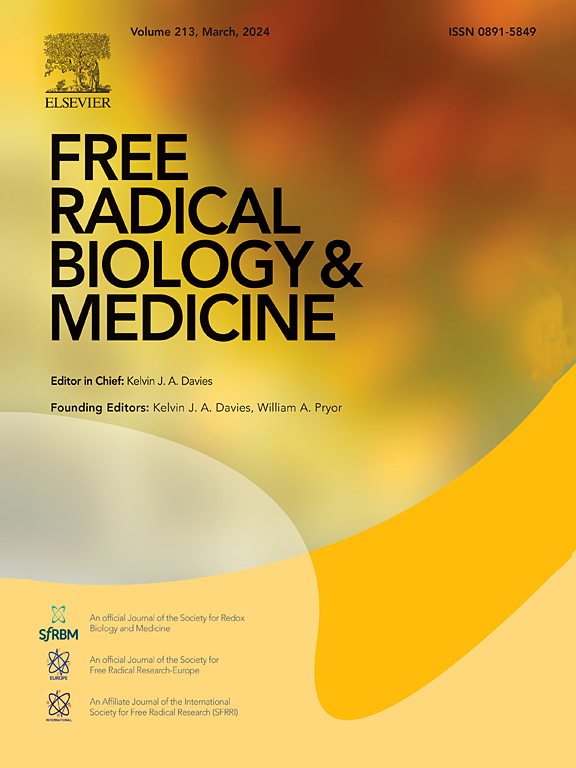锰的可耐受摄入上限可通过激活有丝分裂来缓解帕金森病样运动表现和神经元损失。
IF 8.2
2区 生物学
Q1 BIOCHEMISTRY & MOLECULAR BIOLOGY
引用次数: 0
摘要
锰(Mn2+)是人体不可或缺的微量元素之一,但摄入高剂量的 Mn2+ 会导致锰中毒。因此,不同国家为正常人制定了 Mn2+ 的耐受摄入上限(UL)。然而,Mn2+的UL是否适合帕金森病(PD)患者尚不清楚。在这里,我们意外地发现,在 MPTP 诱导的小鼠和细胞中,通过 PINK1/parkin 介导的泛素依赖途径,膳食中补充的 Mn2+ UL 可增强线粒体吞噬作用。Mn2+ 可促进线粒体的生物生成和动态变化,从而提高线粒体呼吸链的活性,恢复线粒体功能。此外,Mn2+ 还能直接提高线粒体超氧化物歧化酶(MnSOD)的活性,从而有助于清除活性氧(ROS),恢复 MPTP 诱导的帕金森病小鼠模型的多巴胺能和运动功能。在SH-SY5Y细胞中也观察到了类似的结果,而使用siRNA敲除parkin或使用有丝分裂抑制剂(Mdivi-1或环孢素A)则取消了Mn2+的神经保护作用。这些研究结果表明,膳食中Mn2+的UL对MPTP诱导的帕金森样病变具有保护作用,其机制涉及激活有丝分裂,这表明通过适度增加膳食中Mn2+的摄入量有可能干预帕金森病。本文章由计算机程序翻译,如有差异,请以英文原文为准。

The tolerable upper intake level of manganese alleviates Parkinson-like motor performance and neuronal loss by activating mitophagy
Manganese (Mn2+) is among the indispensable trace elements required by the human body, but high-dose Mn2+ exposure can lead to Mn poisoning. Therefore, the tolerable upper intake level (UL) for Mn2+ has been established for normal individuals in different countries. However, whether the UL of Mn2+ is suitable for the patients of Parkinson's disease (PD) is unclear.
Here, we found unexpectedly that the dietary UL of Mn2+ supplement enhanced mitophagy through the PINK1/Parkin-mediated ubiquitin-dependent pathway in MPTP- induced mice and cells. Mn2+ promoted mitochondrial biogenesis and dynamics, thereby increased the activity of the mitochondrial respiratory chain with restored mitochondrial function. Additionally, Mn2+ directly elevated the activity of mitochondrial superoxide dismutase (MnSOD), which contributed to the clearance of reactive oxygen species (ROS), restored dopaminergic and motor functions in the MPTP-induced PD mouse model. Similar results were also observed in SH-SY5Y cells, whereas knockdown parkin using siRNA or application of mitophagy inhibitors (Mdivi-1 or Cyclosporine A), abolished the neuroprotective effects of Mn2+.
These findings demonstrate that the dietary UL of Mn2+ is protective for the MPTP-induced Parkinson-like lesions with the mechanisms involving the activation of mitophagy, suggesting potential intervention of PD by moderately increasing dietary Mn2+ intake.
求助全文
通过发布文献求助,成功后即可免费获取论文全文。
去求助
来源期刊

Free Radical Biology and Medicine
医学-内分泌学与代谢
CiteScore
14.00
自引率
4.10%
发文量
850
审稿时长
22 days
期刊介绍:
Free Radical Biology and Medicine is a leading journal in the field of redox biology, which is the study of the role of reactive oxygen species (ROS) and other oxidizing agents in biological systems. The journal serves as a premier forum for publishing innovative and groundbreaking research that explores the redox biology of health and disease, covering a wide range of topics and disciplines. Free Radical Biology and Medicine also commissions Special Issues that highlight recent advances in both basic and clinical research, with a particular emphasis on the mechanisms underlying altered metabolism and redox signaling. These Special Issues aim to provide a focused platform for the latest research in the field, fostering collaboration and knowledge exchange among researchers and clinicians.
 求助内容:
求助内容: 应助结果提醒方式:
应助结果提醒方式:


